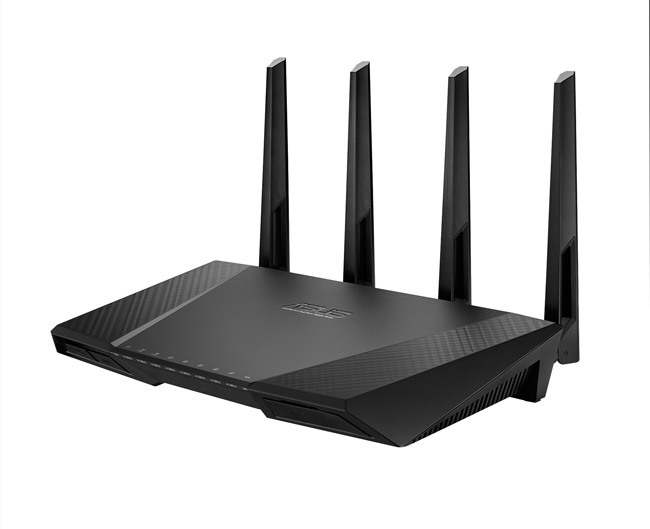ASUS Announces RT-AC87U AC2400 Dual-Band Gigabit Wireless Router – Sep 02, 2014– Taipei, Taiwan (Techreleased) – ASUS today announced RT-AC87U, the world’s first AC2400-class dual-band 802.11ac wireless router with a four-transmit, four-receive (4×4) antenna configuration.

This stunningly-designed, easy-to-use router is also the first in the world to employ multi-user MIMO (MU-MIMO) technology. Combined with ASUS AiRadar universal beamforming, adaptive Quality-of-Service (QoS), plus AiProtection with exclusive Trend Micro security, RT-AC87U is expertly-engineered for outstanding performance and coverage in today’s multi-device households. Offering 5GHz speeds that are faster than wired Gigabit Ethernet, along with class-leading 2.4GHz speeds and reliable multi-floor coverage, RT-AC87U is the perfect choice for discerning users with busy multi-device home networks who need extreme coverage, lightning-fast performance, rock-solid stability and total peace of mind.
Advanced wireless technology for faster-than-wired speeds
The AC2400-class RT-AC87U has blistering 1734Mbit/s 802.11ac speeds on the 5GHz frequency band — faster than wired Gigabit Ethernet — and uses Broadcom® TurboQAM™ to boost 802.11n 2.4GHz performance from 450Mbit/s to 600Mbit/s with compatible devices such as ASUS PCE-AC681. This gives RT-AC87U an amazing combined maximum concurrent data rate of up to 2334Mbit/s.
Maximum coverage, with no dead spots
The explosive growth in smartphones, tablets, laptops, smart TVs and other Wi-Fi-enabled gadgets means that in a modern household the available wireless bandwidth is often shared between many devices. In standard routers, as more devices are connected the network can become overloaded, leading to instability, lags and slowdowns. RT-AC87U uses four high-performance antennas, four separate spatial data streams, ASUS AiRadar, MU-MIMO and adaptive QoS technology to solve these problems. The 4×4 antennas improve coverage by up to 33% compared to standard 3×3 models, and typically RT-AC87U can effortlessly cover an area up to 465m2, making it ideal for eliminating ‘dead spots’ in large or multi-floor environments.
Supercharged performance with two dual-core processors
At the heart of RT-AC87U is the latest Quantenna™ system-on-a-chip (SoC), featuring its own powerful dedicated dual-core processor that handles all 802.11ac Wi-Fi-related computations. This frees up RT-AC87U’s 1GHz dual-core CPU to perform other processor-intensive system tasks — such as media streaming — much more efficiently. The result is a superb multitasking capability that can easily handle the simultaneous demands of all connected devices, giving an outstandingly-responsive network and also improving USB storage performance.
In our tests using three wired and two wireless PCs to simulate a busy multi-client network, RT-AC87U delivered up to 50% more total throughput (combined 2.4GHz, 5GHz and NAT performance) compared to a typical router with a single 1.2GHz dual-core processor2. USB file transfer performance over Wi-Fi is also improved dramatically — when transferring files to and from SuperSpeed USB 3.0 devices over 802.11ac Wi-Fi, RT-AC87U can perform up to twice as fast as a router with a single 1.2GHz dual-core processor3.
The best-ever internet experience, for all devices
AiRadar uses universal beamforming, which detects the location of devices and individually focuses the wireless signal towards them for optimum reception. This feature even works with previous-generation Wi-Fi devices. The revolutionary and future-proof MU-MIMO technology means that RT-AC87U will be able to connect to multiple MU-MIMO-compatible clients at each device’s maximum speed simultaneously, unlike standard single-user MIMO where individual devices have to wait for sequential data transmissions. This means that as users add more MU-MIMO-enabled devices, the router’s capacity actually increases, giving all users the best possible internet experience4.
Adaptive QoS is a feature that intelligently and automatically prioritizes and allocates available bandwidth to devices and applications as they need it, ensuring smoothly-streaming HD videos, lag-free online gaming, crystal-clear VoIP calls and uninterrupted web browsing.
Total peace of mind — AiProtection with Trend Micro security
Recognizing the increasing complexity and diversity of home networks, and the difficulty of ensuring effective network-wide security, RT-AC87U introduces the powerful new AiProtection feature, with exclusive Trend Micro™ technology. This employs a three-pronged approach to security — prevention, protection and mitigation — that assures total peace of mind. Its state-of-the-art protection continuously safeguards users and all connected devices from malware, malicious websites and other cyber-threats, while safeguarding user privacy and keeping a constant check on network security status. Alerts are raised whenever an infected device or other potential security problems, such as insecure passwords, are found.
1 See http://www.asus.com/Networking/PCEAC68 for details.
2 The actual throughput may vary due to ISP speed, Wi-Fi interference, client distance, environment and other factors.
3 The actual transfer speed may vary due to Wi-Fi interference, client distance, storage devices, environment and other factors.
4 Requires MU-MIMO-enabled clients with up to 3×3 spatial streams.










